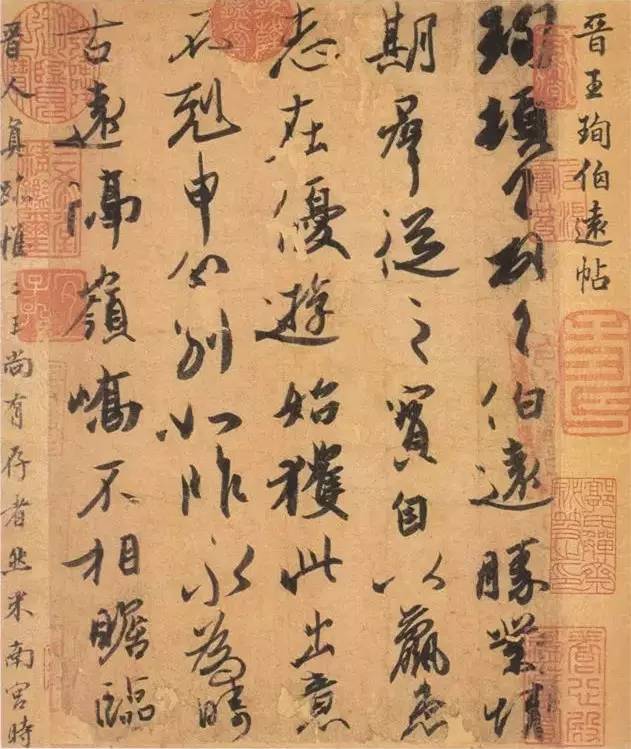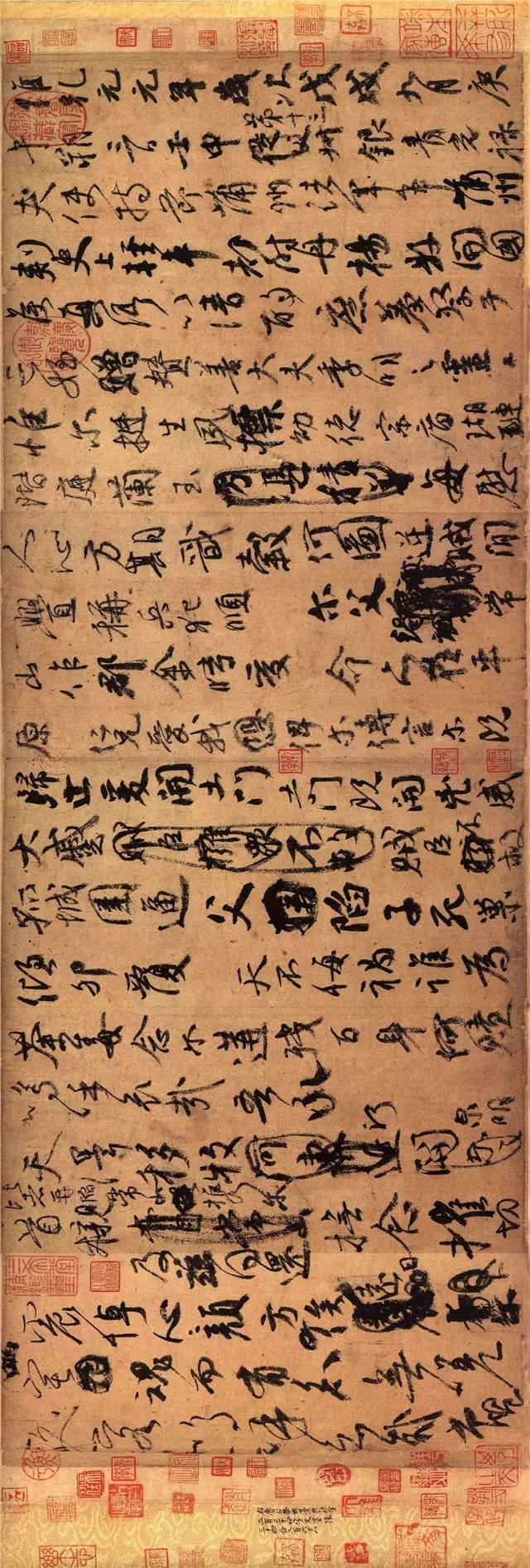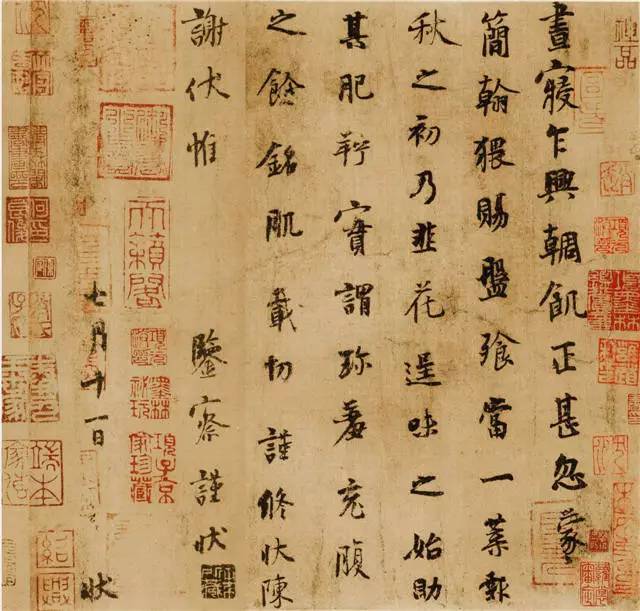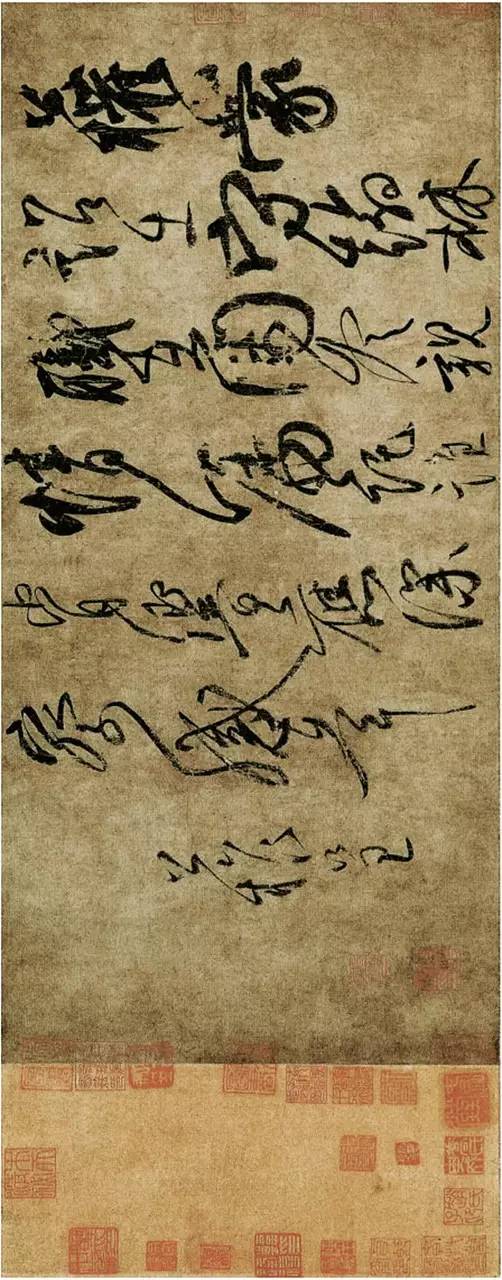

Rising script is developed on the basis of official script. It is a font between regular script and cursive script. It was created to make up for the slow writing speed of regular script and the difficulty of recognizing cursive script. "Xing" means "walking", so it is not as sloppy as cursive script, nor as correct as regular script. In essence, it is calliformation of regular script or regularization of cursive script. Those with more regular script than regular script are called "Xing Kai", and those with more cursive script than regular script are called "Xing Cao".
(Please turn your phone sideways to enjoy)
The "Orchid Pavilion Preface" was written by Wang Xizhi when he was 47 years old. The whole article is written in a calm and gentle manner, full of vigor and concentration. It is revered as "the best running script in the world" by later generations of calligraphers. "Orchid Pavilion Preface" has a total of 300 binary characters and 17 characters. It is written in a natural way, and the structure is changed and the brushwork is changed. It is ingenious but not without traces of arrangement and artificiality. It is indeed well-deserved that such a work based on outstanding qualifications and profound contributions is rated as "the best running script in the world".

(Please turn your phone sideways to enjoy)
"Manuscript for the Memorial to the Nephew", the full name is "A Gift to the Doctor Ji Mingwen for the Memorial to the Nephew". Original on paper, 28.8 cm in length. The width is 75.5 cm, and there are 234 characters in total (there are more than 30 daubed characters). It is now in the National Palace Museum, Taipei.
In May of the first year of Qianyuan (758 A.D.), Yan Gaoqing was posthumously presented by the imperial court as a gift to the crown prince, Taibao, for the "loyalty festival". Yan Zhenqing was the prefect of Puzhou at that time. After hearing the news, he sent Gaoqing's elder, Yan Quanming, to Changshan and Luoyang to search for the remains of Ji Ming and Gaoqing. Only Ji Ming's head and some of Gaoqing's bones were obtained. In order to temporarily bury these bones, Yan Zhenqing wrote this draft of the memorial to his nephew. Because this manuscript was written in a mood of extreme grief and indignation, regardless of the skill of the pen and ink, the characters fluctuate with the calligrapher's emotions, which is purely a natural expression of spirit and peace of mind. This is rare in the entire history of calligraphy. It can be said that "The Manuscript of the Nephew" is one of the original ink works with great historical value and artistic value, and it is extremely precious.

"Huangzhou Cold Food Poetry Post", Paper version, 25 lines, 129 characters in total, is the representative work of Su Shi's running script. This is a poem of rejoicing, a sigh of life that Su Shi uttered during the Cold Food Festival in the third year when he was demoted to Huangzhou. The poem is written in a desolate and sentimental way, expressing Su Shi's melancholy and lonely mood at this time. "Huangzhou Cold Food Poetry Post" shows momentum and is full of ups and downs. Yu Shu of the Yuan and Korean Dynasties called it "the third running script in the world" after Wang Xizhi's "Lanting Preface" and Yan Zhenqing's "Sacred Nephew Draft".

(please Turn the phone across to enjoy)
The paper version of "Boyuan Tie" is named after the word "Boyuan" in the first line. This post is an authentic work of the Jin Dynasty and written by Wang Xun, so it is listed as a treasure of Xizhen. This post is written in running script with strong brushstrokes, desolate style, and charming reuben. It is a typical Wang family's calligraphy style. It was posted at Wu Xinyu's place in Xin'an at the end of Ming Dynasty, and later returned to Wu Ting. It was engraved in "Yu Qing Zhai Tie". In the Qing Dynasty, it was included in the Inner Palace, and it was listed as one of the Sanxitang Fatie together with Wang Xizhi's "Quick Snow and Sunny Tie" and Wang Xianzhi's "Mid-Autumn Tie". It is now in the Beijing Palace Museum.

"Jiuhua Tie" Yang Ning style script, running script, ink on hemp paper, 26 cm high, 28 cm wide, 7 lines in total, 63 characters. "Yiuhua Tie" is a letter, the content is about waking up from a nap, and when I was very hungry, someone gave me a gift of chives, which was very delicious, so I wrote it to express my gratitude.
Dong Qichang once said: "Shaoshi Jiuhuatie, with a little style, has a good sense of style, which is different from that of Shaoshi's other books. However, because of his sideways attitude, Shaoshi is better. place." The font of this post is between cursive script and regular script. "Jiuhua Tie" is known as the fifth running script in the world. Although "Jiuhuatie" is completely different from "Lanting Preface" in terms of writing and composition, its charm is similar to it. There is no golden elixir for exchanging ordinary bones. Who knows that Yang Fengzi in Luoyang can go to Wusilan when he writes." Qing Zeng Xiejun's "Inscribed Chive Flower Post": "The "Chicken Flower Post" is a secret palace of Xuanhe. Yixiong is strong, and Jin people's morality still exists, and it is not unreasonable to compare the valley with "loose monks becoming holy."

(Please turn your phone across to enjoy)
"Mengzhao Tie", ink on paper, also known as "Hanlin Tie", 26.8 cm high, 57.4 cm long, large-character running script, 7 lines, 27 characters, written in In the first year of Changqing (821 A.D.), Liu Gongquan was forty-four years old at that time, in the prime of life, and it was the peak period of his calligraphy creation, so the characters were like a frightened bird hitting the sky, wandering alone, and later generations suspected its falsehood, but Ming Zhan Jingfeng's "Xuan Lan Bian" said: "Liu Chengxuan's ink-marked post is true. The brushwork is vigorous and vertical and horizontal. It is self-made because of Emperor Wen and Daling. It is wonderful and tireless to play with." And There are "Shaoxing", "Han Shineng seal", "Feng's Lu'an Collection of Books and Books Seal", "Anqi Seal" and other seals on the back of the post, indicating that it was once collected by Neifu in Song Dynasty, Han Shineng in Ming Dynasty, Fengquan in Qing Dynasty, and Anqi. Later, it entered the Imperial Palace of the Qing Dynasty and was engraved into the "Sanxitang Fatie", which is now stored in the Palace Museum in Beijing.

This post is majestic, hearty, hearty, sloppy, and magnificent in imagery. It changes shape and changes according to the situation, whether it is long or short, large or small; it is not as positive as Liu Ti regular script, but has a variety of appearances, dangerous and unique, unconventional, and unrestrained, which is rarely seen in the Tang Dynasty. The shackles of strict laws. Its brushwork is not as strong and strong as Liu Ti regular script, but it is rigid and soft, bone and flesh, square or round, exposed or hidden, thick but not bloated, thin and not soft, with lines Focusing on the center, it is full, round and thick, and the brush and ink are well controlled. Just as Zhou Bida said: "Calm and joyful, but elegant and graceful, Ou Yu Chu Xue is insignificant." Changing with the trend, "dry, moist and slender, covering each other, it can't seem like the resurrection."
This post is also called "Ji Ying Post", which is a biography written by Ouyang Xun for Zhang Han. Paper version, 25.2 cm in length and 33 cm in width. There are ten lines in total, with nine to eleven characters in each line. The font is slender and rigorous, the strokes are vigorous and upright, and the style is flat and steep, which is a masterpiece of Oushu.

There is a postscript in thin gold script on the back paper: "The prince of the Tang Dynasty ordered Ouyang to inquire about the book Zhang Hantie. , Emperor Gaozong sighed and said: "The book of inquiry has spread far and wide. In his later years, his writing became more vigorous, and there was a style of law enforcement and court disputes. The isolated peak was rising, and it was cut from all sides. The center of gravity is pressed on the left side, and a strange stroke is pressed to the right side with a mighty force, so that the structure of each character forms a rebellious trend, and then forcefully to the right to turn it into safety, it can be called "seeking in danger". Stability, don’t have fun.” Emperor Qianlong of the Qing Dynasty commented: “It’s wonderful in taking advantage of power, and it’s more than beautiful. "It is very discerning. This post is now in the Palace Museum in Beijing.
"Shu Su Tie" is Mi Fu's third At the age of eighteen (1088), he wrote eight poems in various styles in Shu Su. "Shu Su" is a silk fabric made in Sichuan, with black silk bars woven on it, and it is exquisitely made. According to legend, this volume was in the possession of the Shaw family, and he wanted to invite famous masters to leave his ink treasures for his descendants, but it was handed down for three generations, and no one dared to write it.
Because the texture of silk fabrics is rough and difficult to write, those who do not have profound skills dare not care about it. When Mi Nangong saw it, he "didn't let it go", he swiped it to the end, writing freely and freely, flying with vigor, as if he was like a fish in water. In addition, because silk fabrics are not easy to absorb ink, there are more dry brushes, which makes the ink color throughout the text vary from thick to light, like a thirsty horse rushing to a spring, and it is more exciting and moving. Mi Fu's brushwork is like a painting of bamboo, and he likes to "strike from all sides". The pen used in this post is changeable, with hidden dew on the front and side, long and short, thick and thin, and various postures, which fully embodies his unique style of "brushing characters". The knot characters are also pitched and slanted, with great changes, and the side is the main one, showing a dynamic beauty. Dong Qichang said in the postscript of "Shu Su Tie": "This volume is like a lion fighting an elephant, and I will go all out to it, and it should be a lifelong cooperation."
"Shu Su Tie", a long silk scroll with black silk columns, 29.6 cm high and 284.2 cm long, with 71 lines and 658 characters. The content is eight self-written poems in five or seven characters. In the Ming Dynasty, it was collected by famous collectors such as Xiang Yuanbian, Dong Qichang, and Wu Ting. In the Qing Dynasty, it fell into the hands of Gao Shiqi, Wang Hongxu, and Fu Heng.

Huang Tingjian's "Songfengge Poems" ink on paper, 32.8 cm in length and 219.2 cm in width, the full text consists of 29 lines and 153 characters. Collection of the National Palace Museum, Taipei.
His running script, such as "Songfeng Pavilion. He started from the right to the left, from the Tibetan front in the painting to the Zuodun pen, and then flattened out, "There is no flatness, no unevenness", and he intentionally changed his pen; Be good at Zangfeng, pay attention to setbacks, and use the "bamboo painting method to write calligraphy" to give people a feeling of "calm and happy". Its structure comes from Yan Lugong's "Ba Guan Zhai Hui Bao De Ji", the central palace is tightened, radiating from the center to the outside, stretching vertically and horizontally, like rowing an oar, like a boat, magnificent and majestic. His personality characteristics are very obvious. To learn his calligraphy, we must pay attention to the "calmness and joy" of the stippling brush and the stretch and magnanimity of the structure.

"Tu Mu Tie", running script ink, paper. It is 31.2 centimeters in length and 44.4 centimeters in width, with 10 lines and 104 characters in total. Later, there were postscripts by Xiao Yingao, Wang Yanshi, and Wang Cheng. "Coral Gang", "Calligraphy and Painting Collection", "Moyuan Collection", "Shiqu Baoji Sequel" are described. Collection of the National Palace Museum, Taipei.
Li Jianzhong, born in 945 and died in 1013, was born in Jingzhao (now Xi'an, Shaanxi). Calligrapher of the Northern Song Dynasty. The character is in the middle, and the name is Yan Fu Minbo. Later, he moved to Luoyang with his mother. From the official to the doctor of the Ministry of Industry. Gentle in nature, simple and quiet, elegant in style, not concerned about fame and fortune, once served as the censor platform of Liusi in Xijing. Known as "Li Xitai". I like to travel in the mountains and rivers, and leave more questions. Claiming to be a strict husband and Minbo, he is good at calligraphy, cursive script, official script, seal script, and seal script. He was a famous calligrapher that no one dared to look up to at that time.
This post is one of the "Six Posts from Xitai" handed down from ancient times. The writing style of this post is calm, the law is rigorous, and Ouyang's rate is more charming, and the structure is simple and rigorous. The commentators think that this post is clear and mature, with unrestrained attitude, and won the "two kings" "Brushwork. Li Jianzhong's ink writings are rarely handed down from generation to generation, and "Tumu Tie" is the most typical and orderly of Li Jianzhong's surviving ink writings, so it is also the masterpiece that best shows his profound calligraphy skills, so this post is quite treasured by later generations.

If you are interested in calligraphy, please click here ☞Calligraphy Art Special Training Introductory Class | From Practical to Artistic
Click"Read the original text",
Learn about WIMI Academy
↓↓↓↓↓↓↓
Articles are uploaded by users and are for non-commercial browsing only. Posted by: Lomu, please indicate the source: https://www.daogebangong.com/en/articles/detail/The%20worlds%20top%20ten%20running%20script%20between%20the%20lines%20is%20the%20charm.html

 支付宝扫一扫
支付宝扫一扫 
评论列表(196条)
测试